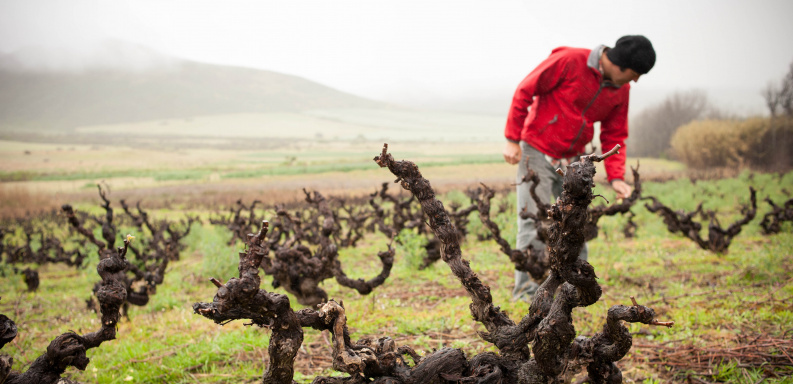Rescuing old vineyards
By Jamie Goode | 8th December 2022
Every year, we hear stories about old vineyards in the Cape being bulldozed. To a non-wine person, this doesn’t sound surprising. After all, these old vineyards often look terrible: old, beaten up, gnarly and past their best. In contrast, we see neat modern vineyards with their uniform growth and tidy rows – surely you’d want these if you are a farmer? And for much wine production, where volume is important, then it’s normal to replant vineyards every 25 years or so. But for wine geeks, there’s something special about old vines, and that’s because in many cases, they yield grapes that are capable of making very fine wines.

Typically, a vine takes three years to come into production. Then there’s the first crop (they might start producing in the second year, but it’s normal to just drop these grapes to help the young vine establish itself). Often, the first couple of harvests give good quality, and then there are a few years when the vine behaves like and adolescent and the quality isn’t really there. Vineyards tend to kick in when they are between 10 and 20 years old, producing consistent high quality. It all depends on the soil type and climate, of course. But it’s when vineyards are very old that they get into their happy place of perfect balance, and hopefully reasonable quantities of these really good grapes.
Of course, not all old vineyards are good, but many of the very best vineyards are old. How old is old? In the case of a remarkable project in South Africa, the cut-off has been set at 35 years. This is the Old Vine Project, the brainchild of viticulturist Rosa Kruger who first came up with the idea in 2002, but which officially was born in 2016. Rosa is assisted in this by Andre Morgenthal. The basis of this project is the SAWIS registry of vineyards, which since 1900 has kept accurate records of vine plantings. Using this, Rosa identified all qualifying vineyards and generated a database of their location, size, varieties and their owners.
The goal of the Old Vine Project is to preserve this heritage of old vines by making sure they are economically viable. Often the vineyards produce less as they age, and if winegrowers aren’t paying farmers a premium for them, they can become economic and liable for uprooting. Also, the fruit from many of them is disappearing into large blends, and so they aren’t being prized for their quality. Since 2018 there has been an Old Vine seal that can go on the neck of a bottle made from grapes from Certified Heritage Vineyards, with the year they were planted marked on it. This is creating an economic incentive to value old vines more highly and thus ensure their survival. Currently 85% of the old vineyards are tied up in the co-op system, and Andre has been trying to convince them to make wines separately from these old vines. ‘We have seven co-op members now,’ he says, ‘and it has totally changed their business model. The grapes that were going into 70 Rand bottles are now selling as premium old vine Chenin at 300 Rand!’
But there are also other aspects to this project. One is to care for the vineyards that will be the old vineyards of tomorrow. Rosa and Andre have been working with the Vititech in Paarl to create a nursery of the best heritage selections. ‘We have managed to save some of this material and clean it up,’ says Andre. ‘We are not only looking after old vines, but we are looking after our future as well: you have to plant to grow old.’
The planting material in the 1970s and 1980s was very poor, and most of these vineyards – especially the reds – couldn’t last longer than 20 years. ‘This is why we have hardly any old red vineyards,’ says Andre, ‘especially Cabernet and Shiraz.’ Most old vineyards are Chenin Blanc, followed a lot further back by Sauvignon, Colombar, Muscat, Pinotage and Cinsault. As of 2022 there were 10 blocks that were centenarian. Back in 2018 there were 48 members of the Old Vine Project; now there are 130. And there are more than 250 wines bottled each year with the heritage seal.
But there’s a new element to preserving vineyards: if all else fails, move them. Several years ago I visited L’Ormarins Estate in Franschhoek, which is home to Antonij Rupert wines. And there I saw something remarkable: an old vine vineyard made of transplanted vines. These vines had been in a vineyard in the Swartland, planted in 1964. But it was about to be bulldozed, with their subsequent loss. But Rosa Kruger, who at the time was working for Antonij Rupert, thought of rescuing them. Now transplanting old olive trees is quite common, but as far as I know it hadn’t been tried on any scale with vines. So this was an experiment. The vines were dug out with a root system preserved of 1 m x 1 m, and they were transplanted to Franschhoek. An underground dripper system was installed to help the roots re-establish themselves, and the take of these old vines was 75%. After a few years of dropping the crop until the root system had re-grown enough, they began making a wine from these Chenin Blanc vines, which is called Die Ou Boostok, and it’s quite beautiful.
More recently, the Old Vine Project have been involved in moving two very old vineyards in the Breedekloof. The results aren’t in yet, but when they are, it could be very interesting and it may pave the way for more of this activity if the results are positive. The key thing in replanting vines is keeping them in their original orientation. ‘If they have had 60 years of the sun rising on one side you need to be careful how you do it,’ says Andre.
